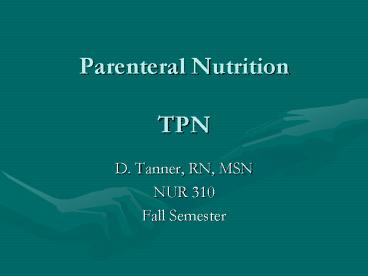Parenteral Nutrition TPN - PowerPoint PPT Presentation
1 / 10
Title:
Parenteral Nutrition TPN
Description:
TPN is a hypertonic solution of dextrose and proteins in the form of amino acids, ... Enteral Nutrition- nutrition thru GI tract- oral, tube feeding ... – PowerPoint PPT presentation
Number of Views:6465
Avg rating:3.0/5.0
Title: Parenteral Nutrition TPN
1
Parenteral NutritionTPN
- D. Tanner, RN, MSN
- NUR 310
- Fall Semester
2
What is this Stuff???
- TPN is a hypertonic solution of dextrose and
proteins in the form of amino acids,
electrolytes, vitamins, minerals and trace
elements infused through an IV- peripheral or
central line. If peripheral it is referred to as
PPN. - Enteral Nutrition- nutrition thru GI tract-
oral, tube feeding - Parenteral Nutrition-nutrition needed/required by
a route other than GI tract.
3
What is this Stuff???
- Each solution is customized- will have a specific
protocol based on pt. needs. Prepared by Pharmacy
but Dietician, MD and Nursing collaborate. - May have a yellow tint and will be in an IV bag
2-3xs larger than normal ( 2,000-3,000 mL). - Lipids (Fat Emulsions) are also a component of
TPN- 10, 20, 30. Give slowly over 12 hours.
Caution if pt has allergy to eggs or at risk for
fat embolism.
4
Indications for TPN
- Pt. with intake less than body requirements and
require sustained nutritional support severe
burns, malnutrition (anorexia), AIDS, CA, severe
sepsis, post-op (especially bowel), trauma. - Pt. cannot tolerate food orally or by gastric
feeding tube - excessive/chronic diarrhea or vomiting,
intestinal obstruction, paralytic ileus,
pancreatitis, malabsorption. - Require 1500 calories/day to keep the body from
using up its own storage of protein. Those with
hypermetabolic states may require up to 10,000
additional calories/day.
5
Nursing Assessment
- We assess for
- 10 deficit in body weight.
- Inability to take oral food and fluids for longer
than a week. - Significant protein loss- indicated by decreased
serum albumin levels. - Muscle Wasting.
- Decreased Tissue Healing.
6
Nursing Diagnoses
- Alteration in Nutrition, less than body
requirements - Hyper/Hypoglycemia
- Electrolyte Imbalance
- Anxiety
- Knowledge Deficit
- Risk for Infection
- Risk for Fluid Volume Deficit/Excess
7
Planning
- Goal for TPN is to achieve optimal level of
nutrition. - Maintain appropriate fld volume- goal is to
provide adequate caloric intake in small fld
volume. - Keep pt free infection and other complications.
- Maintain electrolyte balance.
8
Nursing Interventions
- Administer and Monitor TPN continuously over 24
hours using pump (or cyclic if appropriate). - Daily wt.- we want to see a gradual increase.
- Strict I O.
- Monitor vital signs.
- Monitor lab values - electrolytes, albumin, CBC.
- Accuchecks AC/HS, or per protocol- bc of high
glucose content. May be on SS.
9
Nursing Interventions
- Do not add anything to TPN.
- Must be refrigerated until time to use.
- Encourage activity as tolerated.
- Change Central line dressings per protocol-
usually qod- sterile procedure!!! - Educate pt and family on TPN administration-
frequently they may go home on it!
10
Complications
- Hyper/Hypoglycemia- attempt to avoid this by
infusing TPN at a gradually increasing rate. - Phlebitis/Iv infiltration or catheter related
infections. - Electrolyte imbalances such as hyperK, hypoK,
etc.































